Population declines in Tasmanian devils due to a transmissible cancer may impact spotted-tailed quoll genetics, aligning with ecological expectations. However, the consequences of a top predator's decline on other species' evolutionary genetics remain poorly understood. Study co-author Andrew Storfer highlights the study's rarity in providing evidence for such effects.

Tasmanian Devil joeys are seen at Taronga Zoo on October 22, 2009 in Sydney, Australia.
A Ripple Effect on Evolutionary Genetics From a Predator's Decline
Over the past three decades, Tasmanian devils, native to the island of Tasmania in Australia, have faced a significant threat in the form of devil facial tumour disease (DFTD), a contagious cancer transmitted through biting. This infectious disease has caused a drastic decline in the devil population, dropping from 53,000 in 1996 to 16,900 in 2020.
Intrigued by the ecological implications, researchers Andrew Storfer and Marc Beer from Washington State University explored how this decline in devil numbers might be influencing another marsupial, the spotted-tailed quoll, which shares similar nocturnal habits and dietary preferences with devils.
The study, titled "Disease-driven top predator decline affects mesopredator population genomic structure" published in Nature Ecology & Evolution, analyzed 3,431 genetic variants in 345 spotted tailed-quolls across 15 generations to identify changes in gene variation and selection linked to the prevalence of DFTD in Tasmanian devils and its population density.
Despite spotted tailed-quolls generally avoiding Tasmanian devils due to the latter's larger size and aggressiveness, the researchers found potential genetic shifts in spotted tailed-quolls associated with the changes in devil populations caused by DFTD.
Globally, declines in top predator populations have cascading effects on ecosystems, including reduced competition and increased activity of mid-range predators known as mesopredators. In the case of Tasmanian devils, the decline due to DFTD has altered the resource use and activity patterns of spotted-tailed quolls, which are considered mesopredators in the ecosystem.
The researchers found genetic similarities among spotted tailed-quolls in areas with similar DFTD prevalence, suggesting selective dispersal and potential adaptation to the changing environmental conditions caused by the decline in devil populations.
Genetic Adaptations and Eco-Evolutionary Dynamics
In regions with similar Devil Facial Tumour Disease (DFTD) spreading rates, spotted-tailed quolls exhibited greater genetic similarity, reflecting potential adaptation to the decline in devil populations.
The study identified 12 gene variants in quolls linked to devil population density and 10 associated with the duration of DFTD prevalence in devils. These genes, crucial for movement, muscle development, and feeding behavior, demonstrated the impact of changes in devil numbers on the genetic makeup of quolls.
The research highlighted an increase in genetic variation distribution among quolls, yet a decrease in genetic exchange, possibly due to reduced need for movement in low-density devil areas. This decreased genetic exchange can lead to lower genetic diversity within populations, with unknown evolutionary consequences.
Moreover, the findings showed a decreased gene flow and increased population structure in quolls, indicating reduced competition, and identified traits related to muscle development, locomotion, and feeding behavior subject to selection as devil numbers declined. The authors propose their "community landscape genomics" approach for understanding the evolutionary effects of global predator declines.
RELATED ARTICLE: Conservation and Relocation of Tasmanian Devils Endanger Local Little Penguin Population and Threatens Bird Species
Check out more news and information on Endangered Animals in Science Times.



![Earth's Quasi-Moon Kamo‘oalewa Could Originate From Lunar Surface Not Asteroid Belt [Study]](https://1721181113.rsc.cdn77.org/data/thumbs/full/53275/89/56/50/40/earths-quasi-moon-kamo-oalewa-could-originate-from-lunar-surface-not-asteroid-belt-study.png)










